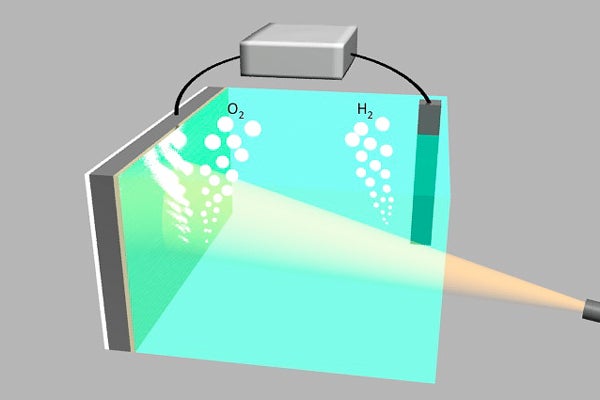A Moment We've Been Waiting For: Stanford scientists develop water splitter that runs on ordinary AAA battery
Hongjie Dai and colleagues have developed a cheap, emissions-free device that uses a 1.5-volt battery to split water into hydrogen and oxygen. The hydrogen gas could be used to power fuel cells in zero-emissions vehicles
By Mark Shwartz
 Stanford graduate student Ming Gong, left, and Professor Hongjie Dai have developed a low-cost electrolytic device that splits water into hydrogen and oxygen at room temperature. (Photo by Mark Shwartz / Stanford Precourt Institute for Energy)
Stanford graduate student Ming Gong, left, and Professor Hongjie Dai have developed a low-cost electrolytic device that splits water into hydrogen and oxygen at room temperature. (Photo by Mark Shwartz / Stanford Precourt Institute for Energy)
In 2015, American consumers will finally be able to purchase fuel cell cars from Toyota and other manufacturers. Although touted as zero-emissions vehicles, most of the cars will run on hydrogen made from natural gas, a fossil fuel that contributes to global warming.
Now scientists at Stanford University have developed a low-cost, emissions-free device that uses an ordinary AAA battery to produce hydrogen by water electrolysis. The battery sends an electric current through two electrodes that split liquid water into hydrogen and oxygen gas. Unlike other water splitters that use precious-metal catalysts, the electrodes in the Stanford device are made of inexpensive and abundant nickel and iron.
"Using nickel and iron, which are cheap materials, we were able to make the electrocatalysts active enough to split water at room temperature with a single 1.5-volt battery," said Hongjie Dai, a professor of chemistry at Stanford. "This is the first time anyone has used non-precious metal catalysts to split water at a voltage that low. It's quite remarkable, because normally you need expensive metals, like platinum or iridium, to achieve that voltage."
In addition to producing hydrogen, the novel water splitter could be used to make chlorine gas and sodium hydroxide, an important industrial chemical, according to Dai. He and his colleagues describe the new device in a study published in the Aug. 22 issue of the journal Nature Communications.
Automakers have long considered the hydrogen fuel cell a promising alternative to the gasoline engine. Fuel cell technology is essentially water splitting in reverse. A fuel cell combines stored hydrogen gas with oxygen from the air to produce electricity, which powers the car. The only byproduct is water – unlike gasoline combustion, which emits carbon dioxide, a greenhouse gas.
This image shows two electrodes connected via an external voltage source splitting water into oxygen (O2) and hydrogen (H2). The illuminated silicon electrode (left) uses light energy to assist in the water-splitting process and is protected from the surrounding electrolyte by a 2-nm film of nickel. (Illustration: Guosong Hong, Stanford University)
Earlier this year, Hyundai began leasing fuel cell vehicles in Southern California. Toyota and Honda will begin selling fuel cell cars in 2015. Most of these vehicles will run on fuel manufactured at large industrial plants that produce hydrogen by combining very hot steam and natural gas, an energy-intensive process that releases carbon dioxide as a byproduct.
Splitting water to make hydrogen requires no fossil fuels and emits no greenhouse gases. But scientists have yet to develop an affordable, active water splitter with catalysts capable of working at industrial scales.
"It's been a constant pursuit for decades to make low-cost electrocatalysts with high activity and long durability," Dai said. "When we found out that a nickel-based catalyst is as effective as platinum, it came as a complete surprise."
Pages: 1 · 2
More Articles
- GAO** Reports: Electronic Cigarettes - US Imports and the Value of US E-cigarette Imports was $2.4 billion; CDC and FDA Campaigns
- Scout Report ... Pride and Prejudice On Open Bookshelf, Biological Macromolecules, Iranica, Volcanism, Phantom Islands, English Playbooks, Chemistry of Life, Logic Problems and Brain Teasers
- Sleep Attack: A Cautionary Tale
- Happy Holidays Aloft: Flight Engineer Peggy Whitson On Third Long-Duration Mission to the International Space Station
- How Many Distracting Systems Needed While Driving? Try Dialing, Changing Music or Sending a Text Using Voice Commands
- Automatic Emergency Braking Systems Available From 10 Car Companies ... And Not Just Luxury Brands
- Indigo: A Technology Has the Potential to Transform the Jeans Dyeing industry From a Polluting Industry Into a Green One
- A Perfect Weekend Diversion: New Sites From the Scout Report Including A Brief History of the Hashtag and Cyberbullying
- Memoirs, Biographies, Historical Fiction and Science Fiction: Recommendations from Jane Gitschier's Bookshelf






